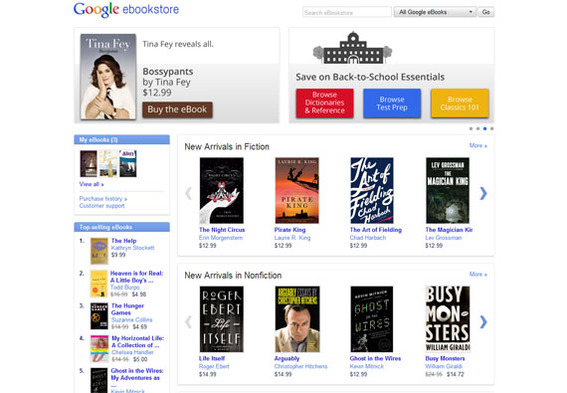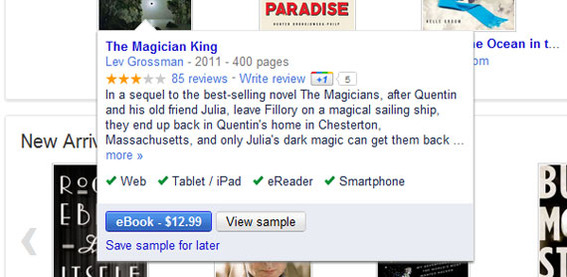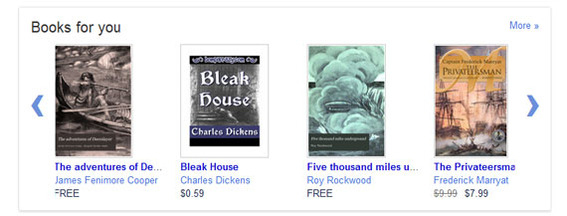Google’s electronic bookstore took months to plan and is considered by some to be a viable competitor to respected brands like Amazon and Barnes & Noble. The crisp clean site has at least four valuable lessons to share with seasoned ecommerce professionals and new entrepreneurs alike.
It has been more than nine months since Google launched its electronic book venture as part of its “mission to improve access to the cultural and educational treasures we know as books.” The site allows for downloaded materials to be read on just about any device, and it may give customers more freedom than some of its competition, according to a New York Times article published when the site launched.
For ecommerce practitioners, Google’s bookstore demonstrates the value of good graphics, free stuff, product quick views, and personalization.
The Google ebookstore’s home page has dozens of product images.
Lesson No. 1: Use Good Graphics
Several recent studies, including “Web aesthetics effects on perceived online quality and satisfaction in the e-tail environment” and “The effects of usability and web design attributes on user preference for ecommerce websites” generally indicate the positive effect that good site graphics, attractive product images, and pleasant site aesthetics may have on shopper’s buying behavior.
Content sliders are located on nearly every page of the ebookstore.
Google’s ebookstore uses clean, clear graphics to promote products and services, features one or more graphics-driven content slider on nearly every page, and uses good quality product images.
To apply this lesson, be sure to invest time and money into site design, layout, and graphics. Also consider using content sliders to show items from featured categories.
Lesson No. 2: Offer Free Stuff
The Google ebookstore has some 2.8 million free titles. Shoppers can download classics like Mary Shelley’s Frankenstein, Charles Dickens’ Great Expectations, or even Mark Twain’s The Adventures of Huckleberry Finn free of charge. In truth, this costs Google very little since nearly all of the free titles are books that are in the public domain. Nonetheless the allure of the world’s largest library of free electronic books no doubt brings shoppers to the site.
The Google ebookstore has more than 2.8 million free titles.
Once a shopper has become accustomed to getting Google’s free books, that shopper will likely return for purchases too.
To apply this lesson, consider offering some items free with purchase or finding items that cost less than the typical cost of customer acquisition. These items can be given away to build relationships. Even free shipping counts.
Lesson No. 3: Use Quick Views
Google’s ebookstore makes extensive use of product quick views, which allow a shopper to get a book synopsis, format information, and product reviews without leaving the home page or category page. The feature makes it much easier to browse titles and may encourage shoppers to consider books that would have been overlooked if clicking to another page were required.
Product quick views give shoppers basic product information without requiring a click.
To apply this lesson, a merchant may need a developer’s help. But many good ecommerce platforms include the feature — it may just need to be turned on — and even if something must be developed from scratch, quick views are not particularly difficult.
Lesson No. 4: Make It Personal
Website personalization, or the concept of treating each customer as an individual with specific tastes, is an important trend in ecommerce and, frankly, in business in general. The idea is that the more closely a merchant can meet a particular customer’s needs and desires, the more likely that customer is to purchase.
The Google ebookstore, like many similar stores, makes personal recommendations based on previous purchases or searches.
Personalization is an excellent way to help customers find interesting products.
From the customer’s perspective, these personalized recommendations can be very helpful and may allow the shopper to discover great books that would have otherwise been overlooked.
To apply this lesson, you may need to engage a third-party recommendation engine and begin tagging products so that it is easier to associate them.
Summing Up
The Google ebookstore demonstrates effective use of graphics, how free items may attract shoppers, the use of product quick views to improve user experience, and personalization. Online merchants may be wish to emulate Google in these areas to boost their own business’s bottom line.




